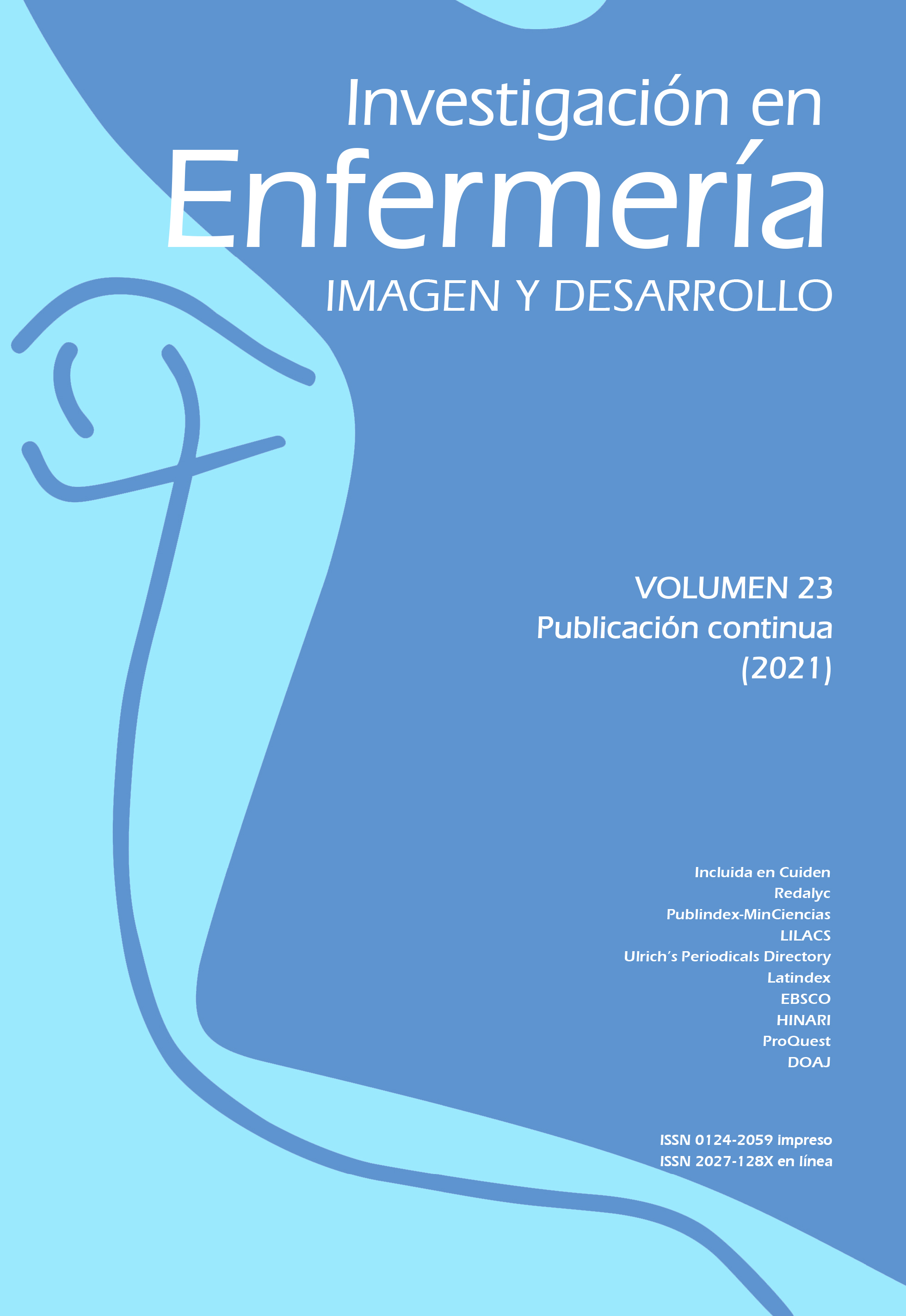Abstract
Introducción: La prevención de infecciones intrahospitalarias es uno de los aspectos más inquietantes en enfermería en los últimos años. Para esto, se han establecido diversas estrategias, entre ellas, los aislamientos hospitalarios. Sin embargo, se encuentra gran dificultad para el cumplimiento de las medidas de aislamiento. Objetivo: Determinar los factores sociodemográficos y de la atención en salud relacionados con el cumplimiento de las precauciones de contacto por parte de los visitantes en un hospital de alta complejidad de la ciudad de Medellín. Método: Se realizó un estudio descriptivo de corte trasversal a un total de 126 visitantes de pacientes aislados por contacto. Se identificaron factores asociados al cumplimiento del aislamiento mediante una encuesta, se analizó la información en el programa SPSS mediante una regresión logística y se asumió significancia estadística si valor P menor a 0,05. Resultados: La adherencia total al aislamiento fue de un 40,5 % y está asociada principalmente con dos factores: disponibilidad de los elementos de protección y estar de acuerdo con el uso de estos. Conclusiones: Los factores mejor asociados con el cumplimiento del aislamiento hacen necesario que las instituciones garanticen suficientes insumos para los visitantes y que tanto el personal de salud como los visitantes reciban una mayor sensibilización en este tema.
Siegel JD, Rhinehart E, Jackson M, Chiarello L. 2007 Guideline for Isolation Precautions: Preventing Transmission of Infectious Agents in Health Care Settings. Am J infection control. 2007;35(10):S65-164. Disponible en: https://www.cdc.gov/infectioncontrol/guidelines/isolation/index.html
Saavedra CH, Ordóñez KM, Díaz JA. Impacto de la infección nosocomial en un hospital de Bogotá (Colombia): efectos en mortalidad y costos. Rev. chil. infectol. 2015;32(1). Feb. http://dx.doi.org/10.4067/S0716-10182015000200004
OMS. Resistencia a los antimicrobianos [Internet]. [Fecha de última actualización: 15 de febrero de 2018, citado 13 de noviembre de 2019]. Disponible en: https://www.who.int/es/news-room/fact-sheets/detail/resistencia-a-los-antimicrobianos.
Álvarez-Lerma F, Gasulla GM, Abad-Peruga V, Pueyo-Pont JM, Tarragó-Eixarch E. Efectividad del aislamiento de contacto en el control de bacterias multirresistentes en un servicio de medicina intensiva. Enfermedades Infecciosas y Microbiología Clínica. 2002;20(2):57-63. https://doi.org/10.1016/S0213-005X(02)72742-0
Organización Panamericana de la Salud. Guía de evaluación rápida de programas hospitalarios en prevención y control de las infecciones asociadas a la atención de salud [Internet]. Washington D.C: 2010. Disponible en: https://www.paho.org/hq/dmdocuments/2011/SPA-Guia-Evaluacion-IAAS.pdf
Martínez MLO, Duran MEM, García OEP, Bonilla HQ, Instituto Nacional de Salud, Protocolo de vigilancia en Salud Publica: Infecciones Asociadas a Dispositivos 2016. Disponible en: https://cruevalle.org/files/PRO-Infecciones-asociadas-a-dispositivos.pdf.
Cohen CC, Cohen B, Shang J. Effectiveness of contact precautions against multidrug-resistant organism transmission in acute care: a systematic review of the literature. J Hosp Infect. 2015;90(4):275-84. https://doi.org/10.1016/j.jhin.2015.05.003.
Munoz-Price LS, Banach DB, Bearman G, Gould JM, Leekha S, Morgan DJ et al. Isolation precautions for visitors. Infection control and hospital epidemiology. 2015;36(7):747-58. https://doi.org/10.1017/ice.2015.67
González-Estrada A, Fernández-Prada M, Martínez-Ortegaa C, Lana-Pérez A. y López-González ML. Cumplimiento de las precauciones de aislamiento de contacto por microorganismos multirresistentes en un hospital de tercer Nivel. Rev Calid Asist. 2016;33(8):486-88. http://dx.doi.org/10.1016/j.cali.2016.01.003
Monsalve C. Adherencia a técnicas de aislamiento en familiares y visitantes de pacientes aislados por vía aérea. [Tesis de posgrado; digital]. [Medellín]: Universidad de Antioquia. 2016. Disponible en: http://bibliotecadigital.udea.edu.co/bitstream/10495/5538/1/MonsalveCindy_2016_AdherenciaFamiliaresPacientes.pdf
Tamayo M, Echeverry LM. Protocolo de aislamientos hospitalarios. Hospital Universitario San Vicente Fundación, versión 3, julio de 2017.
Hospital San Vicente Fundación. Indicadores asistenciales del hospital San Vicente Fundación Medellín creados por el departamento de epidemiología. Aislamientos hospitalarios. Disponible en https://husvp.pensemos.com/suiteve.
Seibert G, Ewers T, Barker AK, et al. What do visitors know and how do they feel about contact precautions? Am J Infect Control. 2018;46(1):115-17. https://doi.org/10.1016/j.ajic.2017.05.011
Bénet T, Girard R, Gerbier-Colomban S, et al. Determinants of Implementation of Isolation Precautions Against Infections by Multidrug-Resistant Microorganisms: A Hospital-Based, Multicenter, Observational Study. Infect Control Hosp Epidemiol. 2017;38(10):1188-95. https://doi.org/10.1017/ice.2017.153
Cuéllar P. de L, Rosales R, Aquiño F. Eficacia de un programa educativo para la prevención y el control de infecciones intrahospitalarias en el Instituto Especializado de Enfermedades Neoplásicas, Lima, Perú. Rev Peru Med Exp Salud Pública. 2004;20(1):37-43. Disponible en: http://www.scielo.org.pe/scielo.php?script=sci_arttext&pid=S1726-46342004000100007&lng=es.

Dieses Werk steht unter der Lizenz Creative Commons Namensnennung 4.0 International.
Copyright (c) 2022 Investigación en Enfermería: Imagen y Desarrollo


